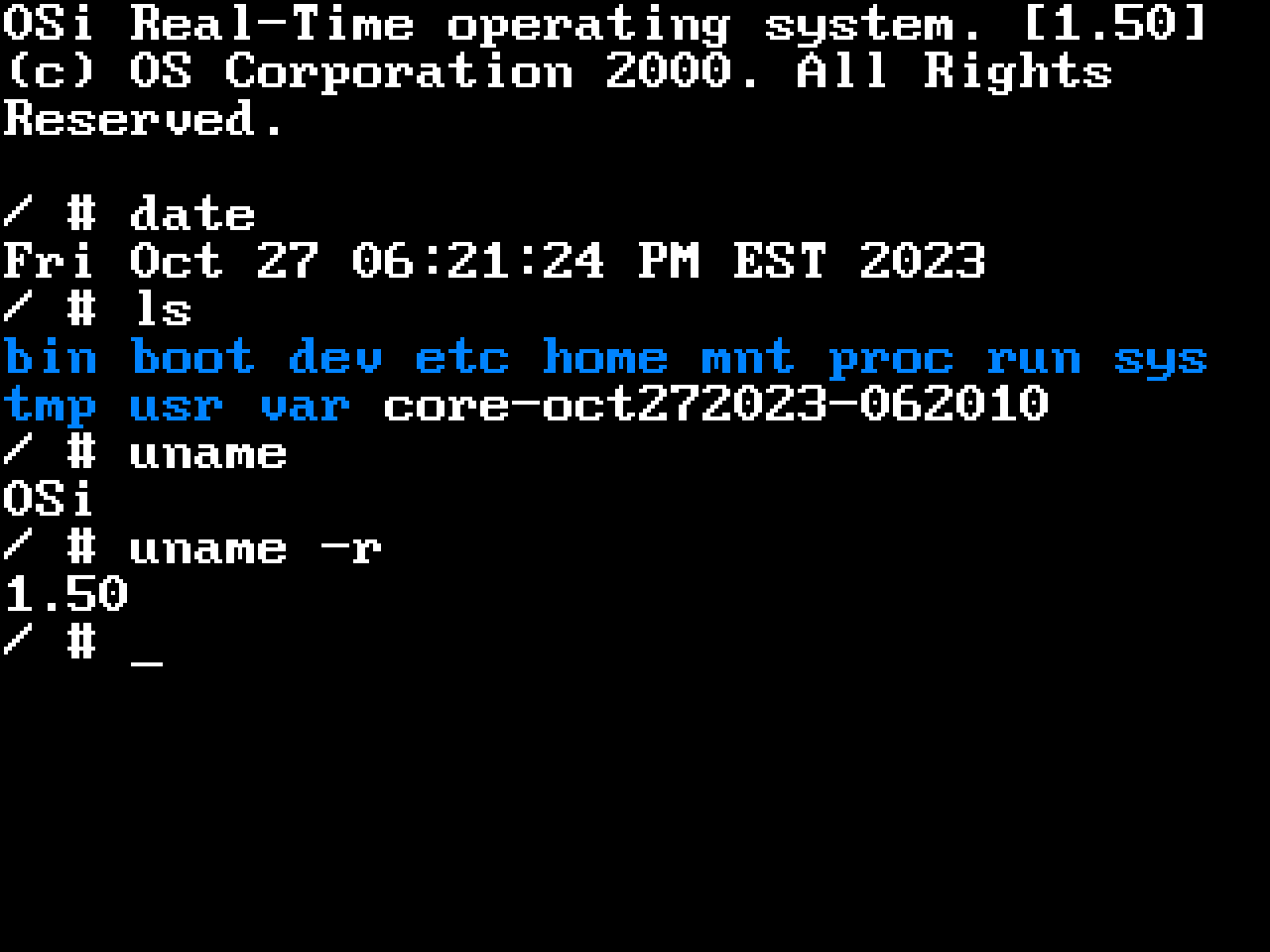OSi: Difference between revisions
No edit summary |
No edit summary |
||
| (One intermediate revision by the same user not shown) | |||
| Line 1: | Line 1: | ||
OSi (formerly known as "DreamOS") is a proprietary embedded, single-user, real-time operating system developed by [[ | [[File:OSi.png|thumb|right|alt=OSi running a partially POSIX-compliant shell. Screenshot by Joshua.|[[OSi]] running a partially POSIX-compliant shell. Screenshot by [[User:JoshuaMV|Joshua]].]] | ||
OSi (formerly known as "DreamOS") is a proprietary, embedded, single-user, real-time operating system developed by [[OS/Corp]]. The name, "OSi", stands for "OS inside". OSi is mostly used in industrial applications, SoCs, POS terminals, thin clients, and compact devices. | |||
Unlike [[OSBlue]], OSi is not a UNIX system or a UNIX-like. OSi shares some features with UNIX, but it is an independent system. It is similar in some ways to Windows CE. | Unlike [[OSBlue]], OSi is not a UNIX system or a UNIX-like. OSi shares some features with UNIX, but it is an independent system. It is similar in some ways to Windows CE. | ||
OS/Corp licenses OSi to original equipment manufacturers (OEMs) who can modify the operating system and add their own user interface, or use a standard GUI provided by OS/Corp. | |||
OSi can be compiled for most CPU architectures. | OSi can be compiled for most CPU architectures. | ||
| Line 19: | Line 21: | ||
== History == | == History == | ||
In 1999, | In 1999, OS/Corp began working on a real-time desktop operating system called DreamOS, designed for brain-computer interface devices which could run independently of a PC. The operating system's default graphical user interface bared striking resemblance to another operating system that was also used in brain-computer interfaces, unfortunately, this did not bode well for OS/Corp. In the year 2000, OS/Corp was sued and was asked to scrap DreamOS's current GUI and change its name. DreamOS's name was changed to OSi, the default GUI was removed and rewritten, and development continued. | ||
[[Category:Software]] [[Category: | [[Category:Software]] [[Category:OS/Corp]] | ||
Latest revision as of 10:49, 30 December 2023

OSi (formerly known as "DreamOS") is a proprietary, embedded, single-user, real-time operating system developed by OS/Corp. The name, "OSi", stands for "OS inside". OSi is mostly used in industrial applications, SoCs, POS terminals, thin clients, and compact devices.
Unlike OSBlue, OSi is not a UNIX system or a UNIX-like. OSi shares some features with UNIX, but it is an independent system. It is similar in some ways to Windows CE.
OS/Corp licenses OSi to original equipment manufacturers (OEMs) who can modify the operating system and add their own user interface, or use a standard GUI provided by OS/Corp.
OSi can be compiled for most CPU architectures.
Features
OSi is optimized for underpowered devices, it requires only one megabyte of memory and very little processing power. It is also able to run on a large variety of devices, ranging from embedded computer chips in consumer electronics, to industrial machinery and supercomputing clusters.
OSi is easy to develop for. Developer packages include a full SDK that can be used to develop and test software before deployment on an OSi device.
OSi can be bundled with (or without) a fully-fledged desktop environment or mobile GUI, allowing it to be used for things like low-cost home computers or mobile devices.
OSi includes a command-line shell, which can be accessed via a serial console or terminal program, it can be used for debugging, file management, configuration, system control, or launching applications.
History
In 1999, OS/Corp began working on a real-time desktop operating system called DreamOS, designed for brain-computer interface devices which could run independently of a PC. The operating system's default graphical user interface bared striking resemblance to another operating system that was also used in brain-computer interfaces, unfortunately, this did not bode well for OS/Corp. In the year 2000, OS/Corp was sued and was asked to scrap DreamOS's current GUI and change its name. DreamOS's name was changed to OSi, the default GUI was removed and rewritten, and development continued.
